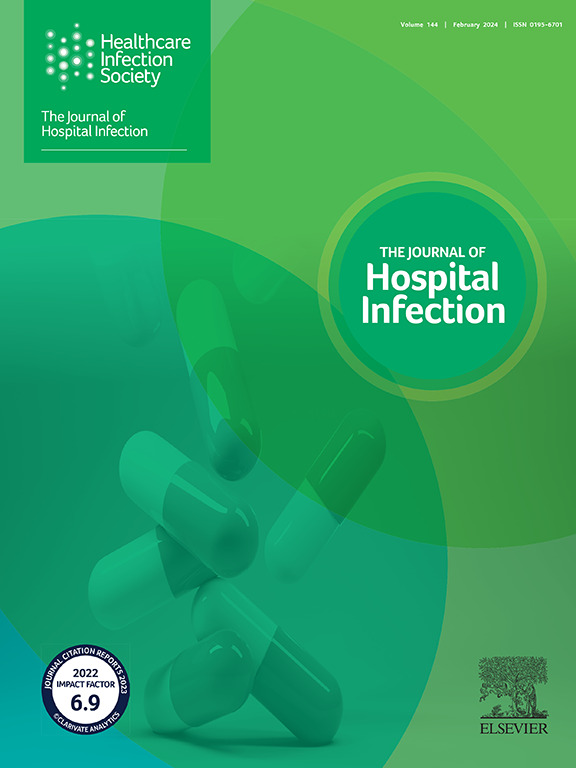对来自重症监护室机械通气患者的呼吸道金黄色葡萄球菌分离物进行为期两年的纵向比较基因组分析。
IF 3.9
3区 医学
Q1 INFECTIOUS DISEASES
引用次数: 0
摘要
背景:呼吸机相关性肺炎(VAP)是重症监护病房的主要医源性感染,金黄色葡萄球菌是早期 VAP 的首要病原体:主要目的是利用全基因组测序技术(WGS)对机械通气患者下呼吸道样本中连续分离出的金黄色葡萄球菌进行比较,以确定潜在的交叉传播。次要目的是确定金黄色葡萄球菌 WGS 数据与金黄色葡萄球菌早期 VAP 患者之间的潜在联系:研究设计:和方法:纳入两年内所有有呼吸道金黄色葡萄球菌分离记录的 MV 患者。WGS 可进行分型、比较基因组和系统发育分析,以及抗生素耐药基因和毒力基因分析。对发生呼吸道感染事件和未发生呼吸道感染事件的患者的毒力基因进行了比较:共对来自 167 名患者的 172 株金葡菌分离物进行了测序。WGS显示,金黄色葡萄球菌群体是多克隆的,只有两个潜在的医疗保健交叉传播,每个涉及两个分离株(2.3%)。耐药率很低,基因型/表型关联性很强,毒力特征高度依赖于序列类型。在 VAP 与毒力特征之间没有观察到明显的相关性:这项对 MV 患者连续呼吸道金黄色葡萄球菌分离物的研究显示,交叉传播的程度很低。金黄色葡萄球菌 WGS 数据与 VAP 发生率之间没有关联。本文章由计算机程序翻译,如有差异,请以英文原文为准。
Longitudinal two-year comparative genomic analysis of respiratory Staphylococcus aureus isolates from intensive care unit mechanically ventilated patients
Background
Ventilator-associated pneumonia (VAP) is the main healthcare-associated infection in intensive care units with Staphylococcus aureus as the first pathogen in early VAP.
Aim
To compare, using whole-genome sequencing (WGS), consecutive S. aureus isolates from lower respiratory samples of mechanically ventilated patients for identification of potential cross-transmissions; and to determine a potential link between S. aureus WGS data and patients with S. aureus early VAP.
Methods
All mechanically ventilated patients with a documentation of respiratory S. aureus isolates were included over a two-year period. WGS allowed typing, comparative genomic and phylogenic analyses, as well as analyses of antibiotic resistance genes and virulence genes. Virulence genes were compared between patients who developed respiratory infectious event and those who did not.
Findings
A total of 172 S. aureus isolates from 167 patients were sequenced. WGS revealed that the S. aureus population was polyclonal with only two potential healthcare cross-transmissions, each involving two isolates (2.3%). A very low resistance rate was observed with a strong genotypic/phenotypic association, and with a virulence profile highly dependent on the sequence type. No significant correlation was observed between VAP and virulence profile.
Conclusion
This study on consecutive respiratory S. aureus isolates of mechanically ventilated patients revealed a very low level of cross-transmission. No association was observed between S. aureus WGS data and VAP occurrence.
求助全文
通过发布文献求助,成功后即可免费获取论文全文。
去求助
来源期刊

Journal of Hospital Infection
医学-传染病学
CiteScore
12.70
自引率
5.80%
发文量
271
审稿时长
19 days
期刊介绍:
The Journal of Hospital Infection is the editorially independent scientific publication of the Healthcare Infection Society. The aim of the Journal is to publish high quality research and information relating to infection prevention and control that is relevant to an international audience.
The Journal welcomes submissions that relate to all aspects of infection prevention and control in healthcare settings. This includes submissions that:
provide new insight into the epidemiology, surveillance, or prevention and control of healthcare-associated infections and antimicrobial resistance in healthcare settings;
provide new insight into cleaning, disinfection and decontamination;
provide new insight into the design of healthcare premises;
describe novel aspects of outbreaks of infection;
throw light on techniques for effective antimicrobial stewardship;
describe novel techniques (laboratory-based or point of care) for the detection of infection or antimicrobial resistance in the healthcare setting, particularly if these can be used to facilitate infection prevention and control;
improve understanding of the motivations of safe healthcare behaviour, or describe techniques for achieving behavioural and cultural change;
improve understanding of the use of IT systems in infection surveillance and prevention and control.
 求助内容:
求助内容: 应助结果提醒方式:
应助结果提醒方式:


